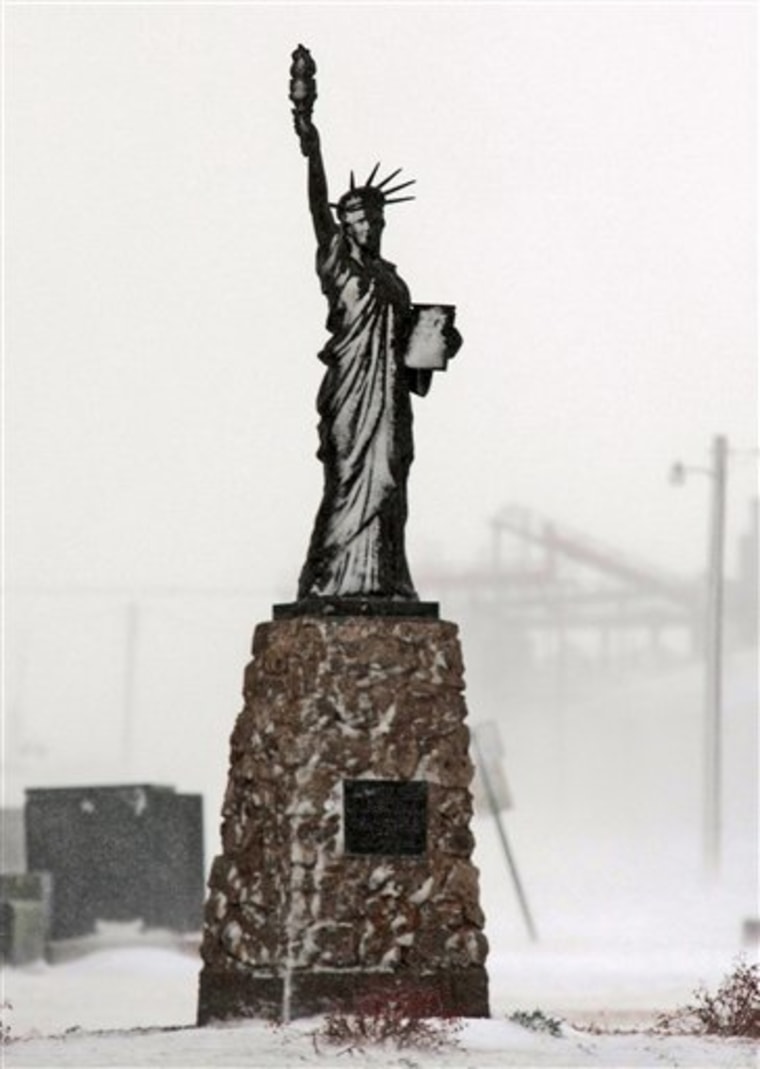Wind-blown snow whipped across the northern Plains on Tuesday, closing major highways, as a powerful storm stalled over western Nebraska and South Dakota.
In neighboring Montana, the Army National Guard dispatched two helicopters to help locate motorists stranded by a snowstorm in southeastern part of the state.
"We do know we have some motorists out there, but we don't know where. So we have a serious situation," Charity Watt Levis, a spokeswoman for the Montana Department of Transportation, told The Associated Press.
Nearly 2 feet of snow had piled up in South Dakota's rugged Black Hills, and the storm system also had generated tornadoes.
The blowing snow cut visibility and piled up in drifts as much as 4 feet high in parts of Wyoming.
"We have wind gusts to 62 mph at Valentine this morning," said National Weather Service meteorologist Clifford Cole in North Platte, Neb.
A wind gust was clocked at 80 mph in Rapid City, S.D., early Tuesday, and Hettinger in southwestern North Dakota measured a gust to 55 mph.
The weather service posted blizzard warnings Tuesday for western sections of South Dakota and Nebraska, eastern Wyoming and the southeast corner of Montana.
Much of western South Dakota was shut down Tuesday for a second day, with Interstate 90 closed from the Wyoming line to Chamberlain, a distance of 266 miles, and the South Dakota Transportation Department advised against travel in most of the region.
Snowplows sidelined
Visibility was so poor that the South Dakota Department of Transportation pulled snowplows off the roads.
"It's a safety concern primarily," the DOT's Gary Engel said. "In the November blizzard we didn't do our closure quite as soon in that one, and we had trucks stopped right on the road. We had trucks stuck in the ditch because they couldn't see where they were going."
North Dakota closed Interstate 94 between Bismarck and Dickinson, about 120 miles.
"The plows couldn't just even be out there. They just couldn't see what they were doing," Highway Patrol Capt. Eric Pederson said.
Several state and national highways that lace the Nebraska Panhandle were closed because of icy pavement and near whiteout conditions, including a section of I-80 into Wyoming.
Forecasters said travel conditions would gradually improve as the storm moved east Tuesday.
On Monday, the storm dumped as much as 20 inches of snow on much of Wyoming. By Tuesday morning, the snow had mostly stopped falling there, but wind up to 60 mph kept many major roads and highways closed.
Neb., Iowa twisters
In the turbulent warmer air on the eastern side of the huge storm, tornadoes were reported Monday in eastern Nebraska and Iowa.
Meteorologist Clifford Cole in North Platte, Neb., said a "fairly minor" twister hit near O'Neill on Monday. It destroyed at least one barn, but "we didn't lose any houses; we didn't lose any people," Cole said.
Near Lincoln, the Nebraska Emergency Management Agency said five people were hurt, none seriously, and several buildings were damaged by a possible twister.
Having a blizzard on one end of Nebraska and tornadoes on the other isn't all that unusual, weather service meteorologist Jim Meyer said Tuesday.
In early spring, Meyer said, "Mother Nature is still trying to decide, 'Hey, do I want to have winter or get into spring and summer?' ... You could draw a line roughly down the middle of Nebraska yesterday afternoon."
Farther south, high wind toppled 13 vehicles on a stretch of I-70 in central Kansas. Highway Patrol Lt. Mike Murphy said most of the vehicles were tractor-trailers. Several people were taken to hospitals for treatment.
Wind gusts of more than 60 mph were recorded in Salina, Kan., and gusts of more than 90 mph were reported at a prairie research site about five miles south of Manhattan.
